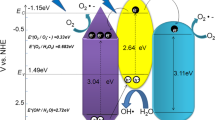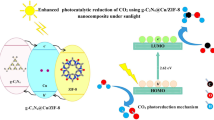Abstract
Photocatalytic nitrogen fixation has attracted much attention due to the fact that it is a way of using solar energy to achieve clean and sustainable conversion of nitrogen to ammonia under mild conditions. In this paper, different proportions of Zn-doped Co3O4 nanopolyhedrons were synthesized using bimetallic ZIFs containing Co2+ and Zn2+ as precursors for the construction of photocatalytic nitrogen fixation semiconductor materials for the first time. The synthesized Co3O4 nano-polyhedron still retains the rhombic dodecahedron shape of ZIF-67 and exhibits a large specific surface area. Moreover, Zn doping results in abundant oxygen vacancies on the surface of Co3O4 polyhedron. These oxygen vacancies not only provide active sites for nitrogen adsorption and activation, but also enhance the separation ability of photocarriers, which can significantly improve the efficiency of photocatalytic nitrogen fixation of the material. When Zn–Co3O4-30 is utilized as the catalyst for photocatalytic nitrogen fixation, the nitrogen fixation rate is 96.8 μmol g−1 h−1, which is much higher than that of pure-Co3O4. In this study, heteroatom-doped Co3O4 polyhedron with rich oxygen vacancy was synthesized by low-temperature oxidation method, which provides a new idea for the design and synthesis of skeleton-based photocatalytic nitrogen fixation materials.
Graphical abstract










Similar content being viewed by others
Data availability
The authors confirm that the data supporting the results of this study are available in the article.
References
Zhao, Y., Zhao, Y., Shi, R., Wang, B., Waterhouse, G. I. N., & Wu, L. Z. (2019). Tuning oxygen vacancies in ultrathin TiO2 nanosheets to boost photocatalytic nitrogen fixation up to 700 nm. Advanced Materials, 31, 1806482.
Wang, L., Li, M., Zhang, Q., Li, F., & Xu, L. (2021). Constructing electron transfer pathways and active centers over W18O49 nanowires by doping Fe3+ and incorporating g-C3N5 for enhanced photocatalytic nitrogen fixation. Inorganic Chemistry Frontiers, 8, 3566–3575.
Li, H., Shang, J., Ai, Z., & Zhang, L. (2015). Efficient visible light nitrogen fixation with BiOBr nanosheets of oxygen vacancies on the exposed (Liu et al.) facets. Journal of the American Chemical Society, 137, 6393–6399.
Wang, L., Zhang, Q., Wei, T., Li, F., Sun, Z., & Xu, L. (2021). WC and cobalt nanoparticles embedded in nitrogen-doped carbon 3D nanocage derived from H3PW12O40@ZIF-67 for photocatalytic nitrogen fixation. Journal of Materials Chemistry A, 9, 2912–2918.
Xue, X., Chen, R., Yan, C., Hu, Y., Zhang, W., & Yang, S. (2019). Efficient photocatalytic nitrogen fixation under ambient conditions enabled by the heterojunctions of n-type Bi2MoO6 and oxygen-vacancy-rich p-type BiOBr. Nanoscale, 11, 10439–10445.
Luo, J., Bai, X., Li, Q., Yu, X., Li, C., & Wang, Z. (2019). Band structure engineering of bioinspired Fe doped SrMoO4 for enhanced photocatalytic nitrogen reduction performance. Nano Energy, 66, 104187.
Banerjee, A., Yuhas, B. D., Margulies, E. A., Zhang, Y., Shim, Y., & Wasielewski, M. R. (2015). Photochemical nitrogen conversion to ammonia in ambient conditions with FeMoS-chalcogels. Journal of the American Chemical Society, 137, 2030–2034.
Xu, J., Fujitsuka, M., Kim, S., Wang, Z., & Majima, T. (2019). Unprecedented effect of CO2 calcination atmosphere on photocatalytic H2 production activity from water using g-C3N4 synthesized from triazole polymerization. Applied Catalysis B, 241, 141–148.
Tian, J., Hao, P., Wei, N., Cui, H., & Liu, H. (2015). 3D Bi2MoO6 nanosheet/TiO2 nanobelt heterostructure: Enhanced photocatalytic activities and photoelectochemistry performance. ACS Catalysis, 5, 4530–4536.
Li, H., Mao, C., Shang, H., Yang, Z., Ai, Z., & Zhang, L. (2018). New opportunities for efficient N2 fixation by nanosheet photocatalysts. Nanoscale, 10, 15429–15435.
Yang, J., Zhang, F., Lu, H., Hong, X., Jiang, H., & Wu, Y. (2015). Hollow Zn/Co ZIF particles derived from core-shell ZIF-67@ZIF-8 as selective catalyst for the semi-hydrogenation of acetylene. Angewandte Chemie. International Ed in English, 54, 10889–10893.
Saliba, D., Ammar, M., Rammal, M., Al-Ghoul, M., & Hmadeh, M. (2018). Crystal growth of ZIF-8, ZIF-67, and their mixed-metal derivatives. Journal of the American Chemical Society, 140, 1812–1823.
Liu, S., Teng, Z., Liu, H., Wang, T., Wang, G., Xu, Q., & Pang, H. (2022). A Ce-UiO-66 Metal-Organic Framework-Based graphene-embedded photocatalyst with controllable activation for solar ammonia fertilizer production. Angewandte Chemie, 134(37), e202207026.
Wang, L., & Øien, A. (1986). Determination of kjeldahl nitrogen and exchangeable ammonium in soil by the indophenol method. Acta Agriculturae Scandinavica, 36, 60–70.
Mitic, V., Nikolic, S., & Stankov-Jovanovic, V. (2010). Kinetic spectrophotometric determination of hydrazine. Open Chemistry, 8, 559–565.
Xiang, K., Xu, Z., Qu, T., Tian, Z., Zhang, Y., & Wang, Y. (2017). Two dimensional oxygen-vacancy-rich Co3O4 nanosheets with excellent supercapacitor performances. Chemical Communications, 53, 12410–12413.
Wen, L., Li, X., Zhang, R., Liang, H., Zhang, Q., & Su, C. (2021). Oxygen vacancy engineering of MOF-derived Zn-doped Co3O4 nanopolyhedrons for enhanced electrochemical nitrogen fixation. ACS Applied Materials and Interfaces, 13, 14181–14188.
Cai, Z., Bi, Y., Hu, E., Liu, W., Dwarica, N., & Tian, Y. (2017). Single-Crystalline ultrathin Co3O4 nanosheets with massive vacancy defects for enhanced electrocatalysis. Advanced Energy Materials, 8, 17016948.
Xu, L., Jiang, Q., Xiao, Z., Li, X., Huo, J., & Wang, S. (2016). Plasma-engraved Co3O4 nanosheets with oxygen vacancies and high surface area for the oxygen evolution reaction. Angewandte Chemie. International Ed in English, 55, 5277–5281.
Xue, Z. H., Zhang, S. N., Lin, Y. X., Su, H., Zhai, G. Y., & Han, J. T. (2019). Electrochemical reduction of N2 into NH3 by donor-acceptor couples of Ni and Au nanoparticles with a 67.8% faradaic efficiency. Journal of the American Chemical Society, 141, 14976–14980.
Hou, C., Hou, Y., Fan, Y., Zhai, Y., Wang, Y., & Sun, Z. (2018). Oxygen vacancy derived local build-in electric field in mesoporous hollow Co3O4 microspheres promotes high-performance Li-ion batteries. Journal of Materials Chemistry A, 6, 6967–6976.
Zhang, Y., Feng, L., Zhan, W., Li, S., Li, Y., & Ren, X. (2020). Co3O4 hollow porous nanospheres with oxygen vacancies for enhanced LiO2 Batteries. ACS Applied Energy Materials, 3, 4014–4022.
Wang, L., Wan, J., Zhao, Y., Yang, N., & Wang, D. (2019). Hollow multi-shelled structures of Co3O4 dodecahedron with unique crystal orientation for enhanced photocatalytic CO2 reduction. Journal of the American Chemical Society, 141, 2238–2241.
Choudhury, B., Dey, M., & Choudhury, A. (2013). Defect generation, dd transition, and band gap reduction in Cu-doped TiO2 nanoparticles. International Nano Letters, 3, 1–8.
Yang, L., Wu, T., Zhang, R., Zhou, H., Xia, L., & Shi, X. (2019). Insights into defective TiO2 in electrocatalytic N2 reduction: Combining theoretical and experimental studies. Nanoscale, 11, 1555–1562.
Wang, X., Li, T.-T., & Zheng, Y.-Q. (2018). Co3O4 nanosheet arrays treated by defect engineering for enhanced electrocatalytic water oxidation. International Journal of Hydrogen Energy, 43, 2009–2017.
Wang, L., Wang, S., Li, M., Yang, X., Li, F., & Xu, L. (2022). Constructing oxygen vacancies and linker defects in MIL-125 @TiO2 for efficient photocatalytic nitrogen fixation. Journal of Alloys and Compounds, 909, 164751.
Zhu, C., Zhu, M., & Sun, Y. (2019). Carbon-supported oxygen vacancy-rich Co3O4 for robust photocatalytic H2O2 production via coupled water oxidation and oxygen reduction reaction. ACS Applied Energy Materials, 2, 8737–8746.
Liu, L., Liu, J., Sun, K., Wan, J., Fu, F., & Fan, J. (2021). Novel phosphorus-doped Bi2WO6 monolayer with oxygen vacancies for superior photocatalytic water detoxication and nitrogen fixation performance. Chemical Engineering Journal, 411, 128629.
Xuan, X., Tu, S., Yu, H., Du, X., Zhao, Y., & He, J. (2019). Size-dependent selectivity and activity of CO2 photoreduction over black nano-titanias grown on dendritic porous silica particles. Applied Catalysis B, 255, 117768.
Han, B., Song, J., Liang, S., Chen, W., Deng, H., & Ou, X. (2020). Hierarchical NiCo2O4 hollow nanocages for photoreduction of diluted CO2: Adsorption and active sites engineering. Applied Catalysis B, 260, 118–208.
`Swain, G., Sultana, S., & Parida, K. (2019). One-Pot-architectured Au-nanodot-promoted MoS2/ZnIn2S4: A novel p–n heterojunction photocatalyst for enhanced hydrogen production and phenol degradation. Inorganic Chemistry, 58, 9941–9955.
Cai, Y. Y., Li, X. H., & Zhang, Y. N. (2013). Highly efficient dehydrogenation of formic acid over a palladium-nanoparticle-based mott-schottky photocatalyst. Angewandte Chemie, 125, 12038–12041.
Ke, J., Liu, J., Sun, H., Zhang, H., Duan, X., & Liang, P. (2017). Facile assembly of Bi2O3/Bi2S3/MoS2 n-p heterojunction with layered n-Bi2O3 and p-MoS2 for enhanced photocatalytic water oxidation and pollutant degradation. Applied Catalysis B, 200, 47–55.
Hao, X., Xiang, D., & Jin, Z. (2021). Amorphous Co3O4 quantum dots hybridizing with 3D hexagonal CdS single crystals to construct a 0D/3D p-n heterojunction for a highly efficient photocatalytic H2 evolution. Dalton Transactions, 50, 10501–10514.
Jiao, S., Fu, X., Zhang, L., Zeng, Y.-J., & Huang, H. (2020). Point-defect-optimized electron distribution for enhanced electrocatalysis: Towards the perfection of the imperfections. Nano Today, 31, 100833.
Liu, Y., Li, Q., Guo, X., Kong, X., Ke, J., & Chi, M. (2020). A highly efficient metal-free electrocatalyst of f-doped porous carbon toward N2 electroreduction. Advanced Materials, 32, 1907690.
Luo, S., Li, X., Zhang, B., Luo, Z., & Luo, M. (2019). MOF-Derived Co3O4@NC with core-shell structures for N2 electrochemical reduction under ambient conditions. ACS Applied Materials and Interfaces, 11, 26891–26897.
Yao, X., Zhang, W., Huang, J., Du, Z., Hong, X., & Chen, X. (2020). Enhanced photocatalytic nitrogen fixation of Ag/B-doped g-C3N4 nanosheets by one-step in-situ decomposition-thermal polymerization method. Applied Catalysis A, 601, 117647.
Pan, Y., Li, D., & Jiang, H. L. (2018). Sodium-Doped C3N4/MOF heterojunction composites with tunable band structures for photocatalysis: Interplay between light harvesting and electron transfer. Chemistry, 24, 18403–18407.
Acknowledgements
This project was financially supported by the Natural Science Foundation of China (Grant No. 22071018), and the Natural Science Foundation of Jilin Province (No. 20220101069JC).
Author information
Authors and Affiliations
Corresponding authors
Ethics declarations
Conflict of interest
The authors declare no competing financial interest.
Supplementary Information
Below is the link to the electronic supplementary material.
Rights and permissions
Springer Nature or its licensor (e.g. a society or other partner) holds exclusive rights to this article under a publishing agreement with the author(s) or other rightsholder(s); author self-archiving of the accepted manuscript version of this article is solely governed by the terms of such publishing agreement and applicable law.
About this article
Cite this article
Li, M., Wang, L., Li, F. et al. Construction of Co3O4 nanopolyhedra with rich oxygen vacancies from ZIF-67 for efficient photocatalytic nitrogen fixation. Photochem Photobiol Sci 22, 1233–1243 (2023). https://doi.org/10.1007/s43630-023-00364-x
Received:
Accepted:
Published:
Issue Date:
DOI: https://doi.org/10.1007/s43630-023-00364-x




